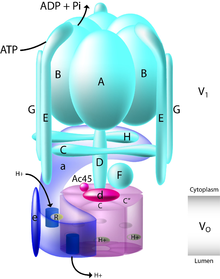User:NOchotny/V-ATPase

Vacuolar type H+-ATPase (V-ATPase) is a highly conserved evolutionarily ancient enzyme with remarkably diverse functions in eukaryotic organisms. V-ATPases acidifiy a wide array of intracellular organelles and pump protons across the plasma membranes of numerous cell types. V-ATPases couple the energy of ATP hydrolysis to proton transport across intracellular and plasma membranes of eukaryotic cells.
Roles played by V-ATPases[edit]
V-ATPases are found within the membranes of many organelles, such as endosomes, lysosomes and secretory vesicles where they play a variety of roles crucial for the function of these organelles. For example, the proton gradient across the yeast vacuolar membrane generated by V-ATPases drives calcium uptake into the vacuole through an H+/Ca++ antiporter system (Ohya, 1991). V-ATPases also play an important role in synaptic transmission in neuronal cells. Norepinephrine enters vesicles in exhange for protons pumped by V-ATPase.
V-ATPases are also found in the plasma membranes of a wide variety of cells such as intercalated cells of the kidney, osteoclasts (bone resorbing cells), macrophages, neutrophils, sperm, midgut cells of insects and certain tumor cells. Plasma membrane V-ATPases are involved in processes such as pH homeostasis, coupled transport and tumor metastasis. V-ATPases in the acrosomal membrane of sperm acidify the acrosome. This acidification activates proteases required to drill through the plasma membrane of the egg. V-ATPases in the osteoclast plasma membrane pump protons onto the bone surface which is necessary for bone resorption. In the intercalated cells of the kidney, V-ATPases pump protons into the urine, allowing for bicarbonate reabsorption into the blood.
V-ATPase structure[edit]
The yeast V-ATPase is the best characterized. There are at least 13 subunits identified to form a functional V-ATPase complex, which consists of two domains. The subunits belong to either the Vo domain (membrane associated subunits, lower case letters on the figure), or the V1 domain (peripherally associated subunits, upper case letters on the figure).
The V1 includes 8 subunits, A-H, with three copies of the 'A' and 'B' subunits, one or two copies of 'E', and two copies of subunit 'G'. The V1 domain contains tissue specific subunit isoforms including 'B', 'C', 'E', and 'G'. Mutations to the B1 isoform result in the human disease distal renal tubular acidosis and sensorineural deafness.
The Vo domain contains 6 different subunits, 'a', 'd', 'c', c', c" and 'e', with possibly four copies of 'c' and one copy of the remaining subunits. The mammalian Vo domain contains tissue specific isoforms for subunits 'a' and 'd', while yeast V-ATPase contains two organelle specific subunit isoforms of 'a', Vph1p and Stv1p. Mutations to the 'a3' isoform result in the human disease infantile malignant osteopetrosis, and mutations to the 'a4' isoform result in distal renal tubular acidosis, in some cases with sensorineural deafness.
The V1 domain is responsible for ATP hydrolysis whereas the Vo domain is responsible for proton translocation. ATP hydrolysis at the catalytic nucleotide binding sites on subunit 'A' drives rotation of a central stalk composed of subunits 'D' and 'F', which in turn drives rotation of a barrel of c subunits relative to the 'a' subunit. The amino-terminal of 'a' (NT-a) along with subunits 'C', 'E', 'G' and 'H' compose the peripheral stalk. The carboxy-terminal of subunit 'a' (CT-a) is held fixed relative to the 'A3B3' head by this peripheral stalk. Movement of the barrel of 'c' subunits past the 'a' subunit is thought to drive proton transport across the membrane. A stoicheometry of two protons translocated for each ATP hydrolyzed has been proposed by (Johnson, 1982).
In addition to the structural subunits of yeast V-ATPase, associated proteins have been identified that are necessary for assembly. These associated proteins are essential for Vo domain assembly and are termed Vma12p, Vma21p and Vma22p (Hirata, 1993; Ho, 1993; Hill, 1994; Jackson, 1997). Two of the three proteins, Vma12p and Vma22p form a complex that binds transiently to Vph1p (subunit 'a') to aid its assembly and maturation (Hill, 1994; Hill, 1995; Graham, 1998; Graham, 2003). Vma21p coordinates assembly of the Vo subunits as well as escorting the Vo domain into vesicles for transport to the Golgi (Malkus, 2004).
V-ATPase Assembly[edit]
Yeast V-ATPases fail to assemble when any of the genes that encode subunits are deleted except for subunits 'H' and c" (Whyteside, 2005; Forgac, 1999; Stevens, 1997). Without subunit 'H', the assembled V-ATPase is not active (Ho, 1993; Parra, 2000) and the loss of the c" subunit results in uncoupling of enzymatic activity (Whyteside, 2005).
The precise mechanisms by which V-ATPases assembly are still controversial with evidence suggesting two different possibilities. Mutational analysis and in vitro assays have shown that preassembled Vo and V1 domains can combine to form one complex in a process called independent assembly. Support for independent assembly includes the findings that the assembled Vo domain can be found at the vacuole in the absence of the V1 domain, whereas free V1 domains can be found in the cytoplasm and not at the vacuole (Kane, 1995; Sumner, 1995). In contrast, in vivo pulse-chase experiments have revealed early interactions between Vo and V1 subunits, specifically the 'a' and 'B' subunits, suggesting that subunits are added in a step-wise fashion to form a single complex in a concerted assembly process (Kane, 1999).
Regulation of V-ATPase activity[edit]
In vivo regulation of V-ATPase activity is accomplished by reversible dissociation of the V1 domain from the Vo domain. After inital assembly, both the insect Manduca sexta and yeast V-ATPases can reversibly disassemble into free Vo and V1 domains after a 2-5 min deprivation of glucose (Kane, 1995). Reversible disassembly may be a general mechanism of regulating V-ATPase activity since it exists in yeast and insects. Reassembly is proposed to be aided by a complex termed RAVE (regulator of H+-ATPase of vacuolar and endosomal membranes) (Kane and Smardon, 2003). Interestingly, dissasembly and reassembly of V-ATPases does not require new protein synthesis but does need an intact microtubular network (Holliday, 2000).
Nomenclature[edit]
The term Vo has a lowercase letter "o", not the number "zero", in subscript. The "o" stands for oligomycin.
